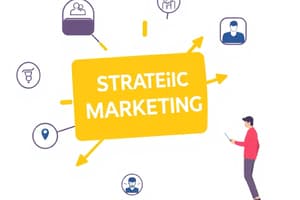Podcast
Questions and Answers
Within the strategic planning process, the acronym SMART is often used to evaluate objectives. However, its effectiveness hinges on several implicit assumptions about the organizational context. Which of the following conditions would most undermine the utility of SMART goals in driving optimal strategic outcomes?
Within the strategic planning process, the acronym SMART is often used to evaluate objectives. However, its effectiveness hinges on several implicit assumptions about the organizational context. Which of the following conditions would most undermine the utility of SMART goals in driving optimal strategic outcomes?
- An organizational culture that strongly emphasizes innovation and rewards risk-taking behaviors.
- A situation where the primary challenge is coordinating complex, interdependent tasks across multiple divisions.
- A rapidly evolving technological landscape where emergent opportunities frequently necessitate strategy pivots.
- A highly stable competitive environment where historical data accurately predicts future market conditions. (correct)
Consider a globally operating consumer goods company contemplating a shift from a production-oriented to a market-oriented approach. Amidst this transition, which capability would be most critical to cultivate for ensuring sustained competitive advantage under conditions of hyper-competition and rapidly shifting consumer preferences?
Consider a globally operating consumer goods company contemplating a shift from a production-oriented to a market-oriented approach. Amidst this transition, which capability would be most critical to cultivate for ensuring sustained competitive advantage under conditions of hyper-competition and rapidly shifting consumer preferences?
- A globally distributed, highly responsive supply chain optimized for minimizing costs through economies of scale.
- A robust, vertically integrated manufacturing infrastructure with capacity for mass customization.
- An advanced, AI-driven predictive analytics system deeply integrated with CRM for personalized marketing.
- A deeply ingrained organizational culture of continuous experimentation and real-time adaptation based on customer feedback. (correct)
Imagine a mature industry characterized by commoditized products, intense price competition, and diminishing profit margins. A firm seeks to achieve sustainable competitive advantage through strategic marketing. Which of the following approaches represents the most viable pathway, assuming resource constraints preclude radical product innovation?
Imagine a mature industry characterized by commoditized products, intense price competition, and diminishing profit margins. A firm seeks to achieve sustainable competitive advantage through strategic marketing. Which of the following approaches represents the most viable pathway, assuming resource constraints preclude radical product innovation?
- Implement a highly targeted segmentation strategy, focusing on niche markets with distinct needs and willingness to pay a premium for specialized service.
- Aggressively pursue cost leadership through economies of scale and operational efficiencies, while maintaining acceptable quality standards. (correct)
- Engage in strategic alliances with key suppliers and distributors to exert greater control over the value chain and reduce transaction costs.
- Invest heavily in persuasive advertising and promotional campaigns designed to create artificial differentiation and brand loyalty.
A multinational corporation is restructuring its strategic planning process to better align with principles of market orientation and to enhance responsiveness to rapidly evolving global market dynamics. Which of the following structural and procedural changes would be most likely to foster a truly adaptive and customer-centric organization?
A multinational corporation is restructuring its strategic planning process to better align with principles of market orientation and to enhance responsiveness to rapidly evolving global market dynamics. Which of the following structural and procedural changes would be most likely to foster a truly adaptive and customer-centric organization?
Within a global firm, corporate strategy, business-level strategy, and marketing strategy must be aligned for optimal performance. However, conflicts can arise when strategic priorities at different levels are misaligned. Which of the following scenarios best illustrates a potentially detrimental misalignment between these strategic levels?
Within a global firm, corporate strategy, business-level strategy, and marketing strategy must be aligned for optimal performance. However, conflicts can arise when strategic priorities at different levels are misaligned. Which of the following scenarios best illustrates a potentially detrimental misalignment between these strategic levels?
A company historically operated under a production-oriented philosophy, prioritizing efficiency and cost minimization in manufacturing. It is now transitioning towards a market-oriented approach. Which changes to core operational metrics would best reflect and support the success of this strategic shift?
A company historically operated under a production-oriented philosophy, prioritizing efficiency and cost minimization in manufacturing. It is now transitioning towards a market-oriented approach. Which changes to core operational metrics would best reflect and support the success of this strategic shift?
Consider two competing firms in the smartphone industry: Firm A, which adheres strictly to a production-oriented philosophy, and Firm B, which embraces a market-oriented philosophy. How might their respective approaches to product portfolio management fundamentally differ, and what potential consequences could arise from these differences in a rapidly evolving technological landscape?
Consider two competing firms in the smartphone industry: Firm A, which adheres strictly to a production-oriented philosophy, and Firm B, which embraces a market-oriented philosophy. How might their respective approaches to product portfolio management fundamentally differ, and what potential consequences could arise from these differences in a rapidly evolving technological landscape?
Organizations often struggle to effectively implement a market-oriented approach due to various internal barriers and resistance to change. Which of the following organizational conditions would most significantly impede the successful adoption of a market-oriented strategy, even with strong support from top management?
Organizations often struggle to effectively implement a market-oriented approach due to various internal barriers and resistance to change. Which of the following organizational conditions would most significantly impede the successful adoption of a market-oriented strategy, even with strong support from top management?
Within the context of strategic marketing, the concept of 'synergy' refers to the combined effect of various marketing activities exceeding the sum of their individual effects. Under what circumstances is achieving true marketing synergy most challenging, and what strategic implications arise from failing to capture these synergistic effects?
Within the context of strategic marketing, the concept of 'synergy' refers to the combined effect of various marketing activities exceeding the sum of their individual effects. Under what circumstances is achieving true marketing synergy most challenging, and what strategic implications arise from failing to capture these synergistic effects?
Consider a rapidly growing technology startup facing increasing competition. While its initial success was based on technological superiority, competitors are quickly closing the gap in terms of product features and performance. Which strategy is most viable?
Consider a rapidly growing technology startup facing increasing competition. While its initial success was based on technological superiority, competitors are quickly closing the gap in terms of product features and performance. Which strategy is most viable?
Flashcards
What is a Strategy?
What is a Strategy?
A fundamental pattern of present and planned objectives, resource deployments, and interactions of an organization with markets, competitors, and other environmental factors.
In simpler terms, what is a strategy?
In simpler terms, what is a strategy?
A strategy is a fundamental blueprint for how an organization will achieve its objectives.
Five Dimensions of Strategy
Five Dimensions of Strategy
Scope, goals and objectives, resource deployments, identification of sustainable competitive advantage, and synergy.
Three Levels of Strategy
Three Levels of Strategy
Signup and view all the flashcards
What does SMART stand for?
What does SMART stand for?
Signup and view all the flashcards
Marketing (AMA definition)
Marketing (AMA definition)
Signup and view all the flashcards
Production Orientation
Production Orientation
Signup and view all the flashcards
Marketing Orientation
Marketing Orientation
Signup and view all the flashcards




